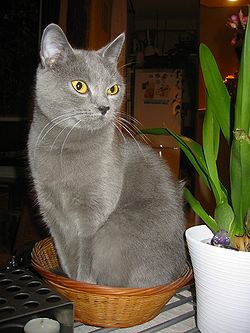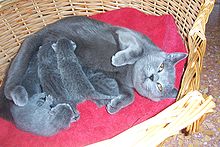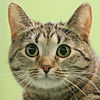Chartreux
| Chartreux | |
|---|---|
| Standard FIFé: CHA, TICA: CX | |
| Fur length | Shorthair cat |
| size | medium to large in size |
| Weight | Male: 6–7 kg. Cat: 4–5 kg |
| allowed colors | all shades of blue |
| colors not allowed | all other colors |
| permitted coat drawing | drawing free |
| not allowed coat drawing | tabby |
| List of cat breeds | |
The Chartreux , known in German vernacular as the Carthusian or Maltese cat since the long-haired variety of the same color of the Angora cat was imported to Europe , is a French pedigree cat with blue-gray fur and amber-colored eyes.
origin
Due to their fur structure, it is assumed that the Chartreux originally came from the mountains of Syria or the rocky mountains between Turkey and Iran . Accordingly, the breed came to France through trade movements with the Middle East and was very important for the fur industry and for food production until the 19th century. Modern breeding began in 1925 by the Léger siblings on the island of Belle-Île , the largest of the Breton islands, as there was a sufficient population of wild gray cats (the forerunners of today's Chartreux).
Although it is obvious, this breed has nothing to do with the Carthusian monks . It is believed that the Chartreux was named after the similar in color, blue-gray type of wool Pile des Chartreux , which was imported from Spain .
history
Since the number of Chartreux was very low in the Second World War and inbreeding was to be avoided, the British Shorthair (BKH) was temporarily crossed with the French Chartreux , which is no longer allowed in the breed associations today. At the beginning of the 1970s, the blue colors of both breeds were combined under the common name Chartreux by the international breed association FIFe , and in Germany and Austria they were Germanized to Carthusian monks . In addition, Persian cats were crossed, which increasingly displaced the characteristics of the original Chartreux; only the typical blue color of the fur and the color of the eyes were essentially reminiscent of this breed.
In parallel, the few original French Chartreux continued to be bred, especially in France and the Benelux countries, but not crossed with other breeds. The characteristics of the Chartreux have been preserved to this day. Through the efforts of the president of the Club Du Chat Des Chartreux, Jean Simonnet, who had presented the differences between the BKH and Chartreux breeds in several publications, the FIFe recognized the Chartreux as an independent breed with its own standard in 1977. Today only the Chartreux Carthusians are allowed to call themselves, but this does not prevent some breeders of the British Shorthair from still referring to the blue representatives of the breed as Carthusians .
Appearance
The Chartreux is strong and muscular, the tomcat bigger than the cat. Both skulls and muzzle are well defined, as is the chest. The head is trapezoidal . In a hangover, the cheeks frame the face like a hood. The medium-sized ears are set relatively narrow and high and stand upright, which gives the face an attentive expression. The slightly slanted eyes have an intense yellow color. The fur is plain blue-gray, short, dense and slightly woolly.
character
The Chartreux is considered an intelligent breed that quickly becomes at home in a new environment and follows its people everywhere. In her native France, they also referred to it as a dog-cat , as they often listening to her name and retrieving can learn.
The voice of this breed is rather fine and calm. In addition to being kept indoors, it is also suitable for being kept free because of its robustness and dense fur. Over centuries of survival in the wild, the Chartreux has preserved the originality of the natural breed to this day.
Breed standard
properties
| Breed standard Chartreux using the example of the Fédération Internationale Féline (Category III - shorthair & somali) | ||
|---|---|---|
| body part | feature | description |
| head | shape | trapezoidal, broad below and narrow above, flat forehead |
| nose | medium length, wide and straight, no snub nose | |
| snout | angular, but relatively small | |
| Ears | shape | medium-sized |
| location | Sitting high on the skull, attentively erect | |
| eyes | shape | large and wide open, not too round, the outer edge of the eye turned slightly upwards |
| colour | lively and clear, dark yellow to deep copper, pure and intense | |
| body | anatomy | strong and muscular with a broad chest |
| legs | shape | medium in length in relation to the body, strong muscles, large paws |
| tail | In the same color as the body, medium length, matching the body, it can be a little thinner, but the tip must be rounded | |
| hide | structure | smooth, dense, woolly undercoat, lush growth, standing upwards |
| colour | All shades of blue are permitted, light blue-gray is preferred, but the decisive factor is the uniformity of the shade | |
| particularities | Cats are significantly smaller than tomcats, with narrower chests and narrower cheeks | |
error
Faults include a snub nose, round eyes, a cloudy or pale eye color and a missing eye rim. Ring drawings on the tail, ghost drawings or other fur drawings on the tail or body are also undesirable .
A round or oriental head shape and green eyes are also not allowed. Defects in the coat include white hair, sand tones, brownish or reddish coat colors and an excessively pronounced color difference between the outer coat and the undercoat.
rating
| Point scale FIFé | ||
|---|---|---|
| Points (total 100) | ||
| head | general shape, nose, jaws and teeth, forehead, chin, placement and shape of the ears | 25th |
| eyes | Shape and size | 30th |
| body | Shape, size, bone structure, shape of the legs and paws | 25th |
| tail | Shape and length | 10 |
| hide | Color, quality and texture, length | 25th |
| Status | 80 | |
Disease disposition
Due to the frequency of blood group B, there is a risk of feline neonatal isoerythrolysis in the kittens when a cat with blood group B is mated with a tom with blood group A or AB .
genetics
In blue cats like the Chartreux, but also the Korat and the British Blue ( BKH ) or Russian Blue, the black eumelanin is diluted to blue by a diluter (= thinner; d / d). The gene that represents the diluter through a mutation has been identified as MLPH ( melanophilin ). It is inherited in a fully pervasive, autosomal recessive manner. The allele turns orange / red cats into cream-colored, chocolate-brown cats into lilac. The mutation is a single missing base pair in exon 2 of the gene that causes transcription to be terminated . This results in enlarged pigment granules that are distributed unevenly in the hair shaft. This results in poorer light absorption and lightening of the fur.
Individual evidence
- ↑ History of the Chartreux at kartaeuser.net
- ↑ History of the Chartreux at Carthusian & Co.
- ^ The Cat Fanciers' Association
- ↑ breed standard FIFe (PDF; 125 kB)
- ^ Christiane Weingart: Blood transfusion in cats. Indications, implementation, transfusion reactions and results (1998–2001). Berlin 2003, (Berlin, Free University, dissertation, 2003; online ).
- ↑ Yasuko Ishida, Victor A. David, Eduardo Eizirik, Alejandro A. Schäffer, Beena A. Neelam, Melody E. Roelke, Steven S. Hannah, Stephen J. O'Brien, Marilyn Menotti-Raymond: A homozygous single-base deletion in MLPH causes the dilute coat color phenotype in the domestic cat. In: Genomics. Vol. 88, No. 6, 2006, pp. 698-705, doi : 10.1016 / j.ygeno.2006.06.006 .
- ↑ homepage.usask.ca
- ↑ Yasuko Ishida, Victor A. David, Eduardo Eizirik, Alejandro A. Schäffer, Beena A. Neelam, Melody E. Roelke, Steven S. Hannah, Stephen J. O'Brien, Marilyn Menotti-Raymond: A homozygous single-base deletion in MLPH causes the dilute coat color phenotype in the domestic cat. In: Genomics. Vol. 88, No. 6, 2006, pp. 698-705, doi : 10.1016 / j.ygeno.2006.06.006 .



